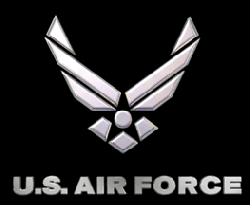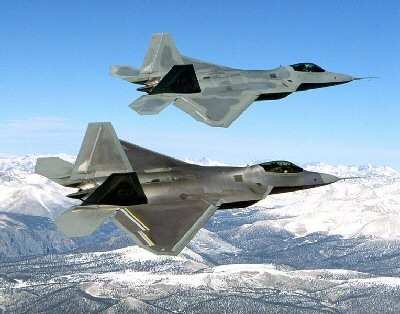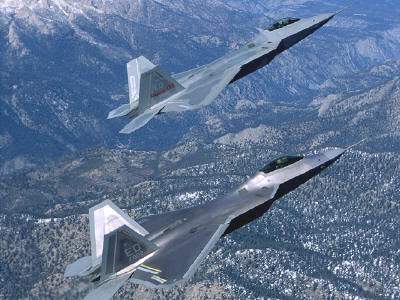 With the F-22A Raptor's initial
operational capability declaration Dec. 15th, came the capstone of
a process that began 76 months earlier, in August 1997, when a C-5
Galaxy landed at Edwards AFB and taxied down the expansive
"Contractor's Row" with several crates and boxes in its cargo bay
for what is now known as the F-22A Combined Test Force.
With the F-22A Raptor's initial
operational capability declaration Dec. 15th, came the capstone of
a process that began 76 months earlier, in August 1997, when a C-5
Galaxy landed at Edwards AFB and taxied down the expansive
"Contractor's Row" with several crates and boxes in its cargo bay
for what is now known as the F-22A Combined Test Force.
Far from being just boxes of materiel or the world's largest
model kit, this cargo, once assembled by the men and women of the
F-22 test force, became the first of what is now officially the air
superiority fighter providing air dominance for the Joint Force,
the F-22A aircraft called "Raptor 1."
The F-22A did not arrive at its current position by accident or
the passage of days. Its present state is a compilation of
thousands of test points successfully flown and analyzed in
maintenance, and of hundreds of Air Force personnel -- active and
civilian-- and of contractors from Lockheed, Boeing, Pratt and
Whitney, Computer Sciences Corporation, Tybrin and JT3 who combined
as one family to do the daily tasks of taking a raw airframe and
turning it into something the world has never seen before.
It was a human undertaking, one that seldom stopped, week in and
week out, with few true weekends off, through the sacrifice of
dozens of holidays. Through labor night and day, the CTF always
sought to complete the building blocks of developmental flight
test, one point at a time over a period of some 2,280 days.

In its final year before IOC, the F-22A continued to rack up
milestones. As the envelope expanded so did the aircraft
capability, as witnessed by the addition of external fuel tanks and
the need to be able to jettison them safely -- a test program that
took weeks to complete.
Not only was there the challenge of how the tanks could
separate, but there was also the need to determine the design
characteristics of external tanks to maintain low-observable, or
stealth, capability for the aircraft.
There was final work done to examine and validate the primary
mission of the Raptor: air-to-air combat. In this area Raptor
pilots flew dozens of hours over the Pacific Ocean and White Sands
Missile Range, N.M., firing the AIM-120 Advanced Medium Range
Air-to-Air Missile at supersonic speed, and while undergoing
dramatic rolling flight profiles not capable by any other aircraft
in the world.

Most recently, the F-22A became the first aircraft in history to
successfully drop a joint direct attack munition from an internal
weapons bay while flying supersonic. And while the more visible
components of final F-22A development testing were coming to a
close, detailed work on the thousands of code items that make up
the software package also continued this year.
The CTF completed all mission avionics testing. This allowed the
Raptor's "go-to-war" status to meet IOC capability and allowed for
the aircraft to operate with the most capable operational flight
program. Also, the F-22A completed all of its clean-wing envelope
expansion testing, the final step to allow Lockheed Martin to
complete its analysis of the plane's operational flight manual to
meet IOC criteria.
Arriving as it did, in the 50th year of the founding of the U.S.
Air Force, and the 50th year of the breaking of the sound barrier
by then Capt. Chuck Yeager, the F-22A stands now at the pinnacle of
all the world's air forces, at the beginning of a new era. [ANN
Thanks John Haire, Air Force Flight Test Center Public Affairs]
 ANN's Daily Aero-Term (05.05.25): Circle To Runway (Runway Number)
ANN's Daily Aero-Term (05.05.25): Circle To Runway (Runway Number) ANN's Daily Aero-Linx (05.05.25)
ANN's Daily Aero-Linx (05.05.25) NTSB Prelim: De Havilland DHC-1
NTSB Prelim: De Havilland DHC-1 Classic Aero-TV: The Boeing Dreamliner -- Historic First Flight Coverage
Classic Aero-TV: The Boeing Dreamliner -- Historic First Flight Coverage Airborne-NextGen 05.06.25: AF Uncrewed Fighters, Drones v Planes, Joby Crew Test
Airborne-NextGen 05.06.25: AF Uncrewed Fighters, Drones v Planes, Joby Crew Test





